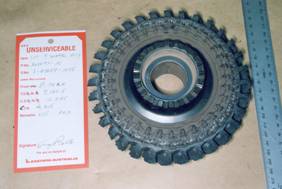The crew of the Fairchild Metro III aircraft, registered VH-DMI, heard a loud bang shortly after application of full power during the take-off roll. The crew immediately retarded both engine power levers and noticed that the left engine exhaust gas temperature was increasing so they shut down the left engine. When a passenger advised that `smoke and fire' were coming from the left engine, the crew discharged the fire bottle into that engine. The crew then shut down the right engine and ordered an evacuation out the right side of the aircraft.
An external examination by the operator's engineers found damage to the left engine turbine blades and shrapnel damage to the exhaust nozzle. The operator removed the engine and sent it to an approved workshop for examination and repair. The Australian Transport Safety Bureau (ATSB) did not attend the examination, but requested that all damaged components be forwarded to the ATSB for detailed examination.
After the engine was disassembled, the ATSB was advised that the engine failure was precipitated by a failure of the turbine first stage disc rotating air seal. The rotating air seal's outer rim was missing and the downstream turbine components received damage consistent with fragments of the rotating air seal passing though the turbine. The failed rotating air seal, the first, second and third stage turbine wheels and nozzle guide vane assemblies were forwarded to the ATSB for further examination.
Engine and component history
The Allied Signal TPE331-12UHR-701G turboprop engine, serial number P-70210, had accumulated 9,139.8 hours and 15,585 cycles since new and 3,066.9 hours since overhaul. In May 1997, it had Allied Signal service bulletin TPE331-72-2002 incorporated, which detailed replacement of the inner baffle with a new inner baffle part number 3108039-2. Service bulletin TPE331-72-2030, that detailed replacement of the compressor interstage seal assembly support, was incorporated in July 1999, at 6,073 hours, during engine overhaul, after overhaul, the engine was installed into DMI where it remained until the failure.
The rotating air seal, part number 3103839-3, serial number 2-23315-945, appeared to have been installed in the engine since new as its time and cycles since new were identical to those applicable to the engine. During the engine overhaul in 1999, it was inspected in accordance with the requirements current at that time and found serviceable.
The ATSB was advised that cracking of the rotating air seals had occurred in the past, but that it was rare to see a cracked rotating air seal on engines that have the requirements of the engine manufacturer service bulletins TPE331-72-2002 and TPE331-72-2030 incorporated.
Rotating air seal examination
The examination of the rotating air seal and other components from the failed engine is detailed in the ATSB's technical analysis report number 40/01. The examination revealed that the entire outer rim of the rotating air seal had separated from the flanged section. About seventy percent of the rim circumference was recovered and most material from the outer ten millimetres of the plate flange was lost.
One location, where the loss of material was substantially greater, exhibited a short length of fracture showing evidence of fatigue crack propagation. Heat tinting over the area of fatigue indicted that it was present prior to the event failure. The seal had no evidence of material or manufacturing anomalies.
Examination of the turbine components
The turbine disks and nozzle guide vane assemblies showed evidence of random impact damage to the blade leading edges. The damage was consistent with the separated pieces of the failed rotating air seal passing through the turbine.
A copy of the ATSB's technical analysis report, number 40/01, is available on the ATSB web site at or from the ATSB on request.
Engine manufacturer's action
The engine manufacturer reported a number of documented in-flight shutdowns due to separation of the rotating air seal plate rim. Their investigation into the events concluded that cracking in the rim area was due to elevated rim operating temperatures, primarily due to hot gas leakage from deteriorated first stage stator assembly hardware. To alleviate the problem, the manufacturer introduced service bulletins TPE331-72-2002 and TPE331-72-2030 and revised the engine maintenance manual to improve inspection of the relevant components at hot section inspection with the intention of preventing hardware prone to gas path leakage from returning to service.



